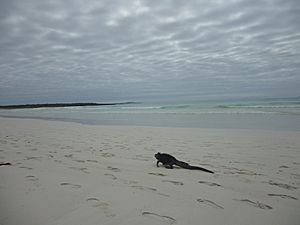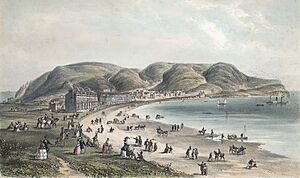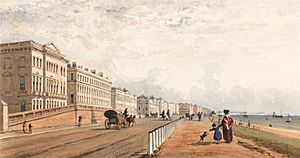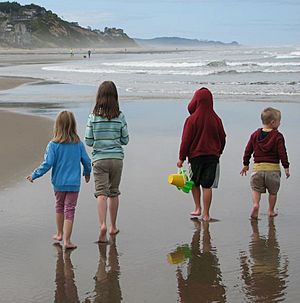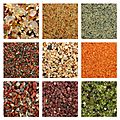Beach facts for kids
A beach is a special place where land meets the ocean, sea, lake, or river. It's usually made of loose bits like sand, gravel, shingle, or pebbles. Sometimes, beach particles are even made from mollusc shells or pieces of coral.
Beaches are natural spots where boats can easily land or launch. People love going to beaches to swim, get a tan, or just relax. The most popular beaches often have soft, light-colored sand and warm water. Some beaches are also famous for great diving or for seeing amazing sea creatures.
Some of the world's most famous beaches include Aruba (Dutch Caribbean), Long Beach (Canada), Copacabana Beach (Brazil), Hot Water Beach (New Zealand), Megan Bay (St. Thomas), Kailua Beach (Hawaii), Zandvoort Beach (Netherlands), Jeffreys Bay (South Africa), and Bondi Beach (Australia).
Taking holidays at the beach became very popular, especially starting in Britain. In the 1800s, railways allowed people to visit places they had never seen. This was part of the industrial revolution, which made tourism possible for many. Whole seaside resort towns grew up to welcome visitors. Soon, beach vacations became popular all over the world.
Beaches are always changing. They can grow bigger or get smaller due to erosion. The line between land and sea is always moving. For example, New Romney in Kent, England, used to be a port right on the sea. But over time, the huge shingle beach of Dungeness grew, cutting it off from the water.
Beaches and their wildlife are super important for our planet. We should always try our best to protect them and the ocean from pollution and trash.
Contents
What Makes Up a Beach?
Beaches have different parts that are shaped by waves and tides:
- Swash zone: This area is covered and uncovered by waves as they roll up the beach.
- Beach face: This is the sloped part below the main beach, where waves wash over.
- Wrack line: This is the highest point the daily tide reaches. You'll often find natural things like seaweed and other bits of debris here.
- Berm: This is a flatter, higher part of the beach that usually stays dry. It only gets wet during very high tides or storms. Sometimes, you can find sand dunes behind the berm.
Even though we often think of beaches by the sea, they can also be found next to lakes and large rivers.
A "beach" can mean:
- Small areas where sand or rocks move around because of waves and currents.
- Much larger areas of land that are part of the Earth's geology.
The main part of a beach that is usually above water is called the beach berm. This is where the sand or other material builds up. The berm has a top part called the crest and a slope leading down to the water called the face. Sometimes, there's a dip called a trough at the bottom of the face. Further out in the water, you might find underwater sand ridges called longshore bars, where waves first start to break.
The sand on a beach can stretch far inland from the berm. You might even see older berms, called storm beaches, which were formed by very big storm waves. If the sand particles are small enough, the wind can blow them further inland, creating dunes.
The way a beach looks, called its beach profile, changes with the seasons. In places with four seasons, beaches are usually higher in summer. This is because calmer waves gently push sand up the beach. In winter, stronger storm waves pull sand away from the beach, making it lower. This sand often forms underwater bars. In tropical areas, the storm season is usually during the summer months.
If big storms happen at the same time as very high tides or huge waves like a tsunami, a lot of sand can be washed away. This can change the shape of the coastline and even create new river deltas.
It's hard to say exactly where a beach ends and a dune begins. Sand is always moving between them. The drift line, where waves deposit material, is one way to tell. Beyond this line, wind can easily move the sand.
Beaches and Fun Activities
How Beach Holidays Began
Beaches became popular places for fun and relaxation in the mid-1800s. At first, in the 1700s, only rich people visited seaside towns for health and enjoyment, just like they went to spa towns. One of the first seaside resorts was Scarborough in Yorkshire, England, in the 1720s. People even used special "bathing machines" by 1735, which were like changing rooms on wheels that could be rolled into the sea.
When Brighton became popular and was visited by King George IV, it made beach visits fashionable for many people in London. The beach became a place for upper-class fun. Writers like Jane Austen even wrote about it. Later, Queen Victoria loved visiting the Isle of Wight and Ramsgate, making seaside homes very trendy for the wealthy.
Beach Trips for Everyone
Beach holidays became popular for middle and working-class people when railways started in the 1840s. Trains offered cheap tickets to growing resort towns. For example, a new railway line to Blackpool led to a huge boom. Many visitors came by train, which encouraged people to build hotels and new attractions.
Blackpool's growth was helped by "wakes weeks." Cotton mills in Lancashire would close for a week each year for repairs. Each town had a different week off, so Blackpool had a steady stream of visitors all summer. A big part of the resort was the promenade and the pleasure piers, where people could enjoy all sorts of shows. The North Pier was finished in 1863, and the Central Pier in 1868, with a theater and outdoor dance floor.
Many popular beach resorts had bathing machines. This was because even the full-body beachwear of the time was thought to be too revealing. By the end of the 1800s, England had over 100 big resort towns.
Beaches Around the World
The love for beaches spread from England to other countries. The French Riviera by the Mediterranean Sea was already a popular spot for wealthy British people by the late 1700s. In 1864, a railway to Nice made the Riviera easy to reach for people from all over Europe. By 1874, 25,000 foreign residents, mostly British, lived in Nice. European royalty, including Queen Victoria and Edward VII, also visited the coast.
In Europe, rules about gambling and beach swimwear were often more relaxed than in Britain. In 1863, the Prince of Monaco, Charles III, and a businessman named François Blanc arranged for steamships and carriages to take visitors from Nice to Monaco. There, they built fancy hotels, gardens, and casinos. This place was renamed Monte Carlo.
Commercial sea bathing also spread to the United States and parts of the British Empire by the late 1800s. In the 1890s, Henry Flagler built the Florida East Coast Railway. This connected new beach resorts like St. Augustine and Miami Beach to winter travelers from the northern U.S. and Canada. By the early 1900s, surfing became popular in Hawaii and Australia, then in southern California by the 1960s. By the 1970s, cheap air travel made it possible for people to visit beaches all over the world, including the Mediterranean Sea, Australia, South Africa, and the U.S. Sun Belt.
Beaches Today

Beaches are very popular on warm, sunny days. In the Victorian era, many popular beach resorts used bathing machines because even the full-body beachwear of the time was considered too revealing. This idea of modesty still exists in some Muslim countries today.
In many countries, the best recreational beaches are given a special "Blue Flag" status. This means they meet high standards for water quality and safety. Losing this status can really hurt a beach's tourism.
Sadly, beaches are often used as dumping grounds for waste and litter. This means we need beach cleaners and other cleanup projects. Pollution from sewage can also be a problem, sometimes causing beaches to close. This can lead to health issues and harm sea creatures.
Artificial Beaches
Some beaches are not natural; they are made by people. These can be permanent or temporary. You can find artificial beaches in places like Monaco, Paris, Copenhagen, Rotterdam, Nottingham, Toronto, Hong Kong, Singapore, and Tianjin.
The relaxing feeling of a beach can be copied in artificial ways. For example, some swimming pools have a "beach style" with a gentle slope into the water, or "wave pools" that create waves like the ocean. Urban beaches are also becoming common in big cities. These parks try to feel like natural beaches, sometimes with fountains that sound like waves.
Beach nourishment is when sand is pumped onto beaches to make them healthier or bigger. This is common in many beach cities. Often, these beaches still look natural, and visitors don't even know they've been helped by people. There are debates about whether to create artificial reefs or use beach nourishment, as people want to protect nature but also improve surfing waves.
Rules for Beach Access
In some parts of the world, public access to beaches is limited. For example, on the Jersey Shore, you might need to buy a "beach tag" to use the beach. Some beaches also don't allow dogs during certain times of the year.
Private Beaches
Some beaches are private, like those owned by a neighborhood group. Signs are usually put up at the entrance. You might need a special permit to use them.
Public Beaches
In the U.S. state of Oregon, public access to beaches is protected by law. The Oregon Beach Bill of 1967 made sure that everyone could freely use the beaches from the Columbia River to the California border.
How Beaches Are Formed
Beaches are shaped mainly by waves and currents. These forces move sand or other loose materials that make up the beach. Particles can be carried in the water or bounce along the bottom.
Beach materials come from rocks eroding offshore, or from cliffs crumbling. For example, some of the whitest sand in Florida comes from quartz rocks eroding in the Appalachian Mountains.
Coral reefs offshore are also a big source of sand. Some fish that eat algae on corals can create a lot of sand over their lives. They nibble the coral, digest the organic parts, and then release the rock and coral bits as sand.
The type of beach material depends on what's upstream and how fast the water and wind are moving. Water and wind move particles based on their size and how tightly packed they are. Particles tend to settle and pack together in calm water, which makes them harder to erode. Plants with strong root systems also help stop erosion by slowing down water flow.
When water or wind moves, it becomes more powerful at eroding if it's carrying a lot of sand or other particles.
The type of sand or rocks on a beach tells you how strong the waves and wind are there. Coasts with very strong waves and winds will only have large rocks, because smaller particles get carried away. Coasts that are protected from waves and winds will have finer materials like clay and mud, creating mud flats or mangrove forests.
The shape of a beach depends on whether the waves are "constructive" or "destructive," and if the beach is made of sand or shingle.
Constructive waves happen when there's enough time between waves for the water to go back and the sand to settle. These waves move material up the beach, making it bigger.
Destructive waves happen when waves come too quickly. The sand doesn't have time to settle, so it gets carried away by currents or receding tides. These waves move material down the beach, making it smaller. During stormy seasons, the water will have more sand and other material floating in it.
On sandy beaches, destructive waves create a gently sloping beach. On pebble and shingle beaches, the water sinks into the large particles more quickly, so the backwash isn't as strong, and the beach stays steep.
Packed fine sand creates a smooth beach surface that resists wind and water erosion. In hot, calm weather, a crust can form on ocean beaches when the sun evaporates the water, leaving salt crystals around the sand. This crust helps protect the beach from wind.
Cusps and horns are uneven shapes you sometimes see on sandy beaches. They form when incoming waves split, depositing sand in some places and washing it away in others.
Beach Changes and Wildlife
How Beaches Change
Beaches are always changing shape because of water and wind. Storms with strong winds or fast-moving water will erode beaches. But currents along the shore often bring new sand, helping beaches recover from storms. Tides also slowly change beaches with each cycle, and over time, these changes can be big.
Plants on Beaches
Changes in a beach's shape can affect the roots of large trees and other plants. Many beach plants, like coconut palms, have strong root systems that help them survive waves and wind. These plants also help keep beaches stable by trapping sand and rainwater. They protect the main part of the beach from strong winds and waves.
Over long periods, beaches with healthy plants tend to grow, while those without plants tend to shrink. Big wave events like tsunamis or storm surges can change a beach's shape in just a few hours.
If plants on the beach are destroyed by chemicals, too many people walking or driving, or changes in freshwater flow, the beach can erode. Even if the plant loss is slow, a big storm can quickly move huge amounts of exposed sand, burying other plants or carrying sand out to sea. This can harm animal habitats. If there's enough sand and plants can't grow back, wind-blown sand can keep moving inland, changing the landscape.
Sand moved by waves can also settle in shallow coastal waters, burying sea grasses and changing the underwater environment.

Clearing or burning plants near the beach for farms or homes changes wind patterns and exposes the beach to wind erosion.
Farming and building also often change how surface water flows. If this water is collected in drains and empties onto the beach, it can erode the beach, creating a lagoon or delta.
Thick plants usually soak up rainwater, slowing down runoff. When natural plants are destroyed, runoff from rain becomes faster and more powerful. This runoff can carry more dirt and plant material from the land onto the beach and into the sea. If this flow is constant, it can change the color, smell, and animals living in the beach sand.
Getting to the Beach
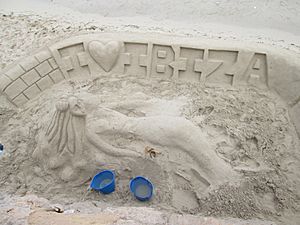
It's important to design good ways to get to the beach, especially if many people or vehicles need access. Letting people walk anywhere across delicate sand dunes can destroy plants and cause erosion.
A well-designed beach access should:
- Have a strong surface that can handle many people or vehicles.
- Look nice and fit in with the natural surroundings.
- Be in a convenient and safe spot.
- Be the right size for the amount of people or vehicles using it.
- Be kept in good condition.
- Have signs and lights to stop people from making their own paths that could harm the beach.
Concrete Ramps or Steps
A concrete ramp should follow the natural shape of the beach so it doesn't change how waves, currents, water, and wind move. If a ramp is too low, it will get buried. If it sticks out too much, it can cause sand to build up in front and wash away behind it. Concrete ramps are expensive to build because they need special concrete or protection from the tide. They are good for busy beaches where regular cars and boat trailers need access. Concrete steps are often used in towns where people walk to the beach in street shoes, or where the road is much higher than the beach. A ramp with steps might let people push strollers or small boat dollies onto the beach. Concrete ramps and steps need to be cleaned to prevent moss or algae, which can make them slippery.
Corduroy (Beach Ladder)
A corduroy or beach ladder is made of wooden planks laid close together, side-by-side, and held by a chain or cable. They form a path or ramp over the sand. Corduroys are cheap, easy to build, and quick to move. They are often used for walking paths and light vehicle access. They naturally fit the beach shape and handle small erosion well. However, they can get buried or washed away by surface runoff. If they are not wide enough for vehicles, the sand next to them can wash away, causing serious erosion.
Fabric Ramps
Fabric ramps are often used by the military for temporary access when the sand underneath is firm. A sheet of strong fabric is laid over the sand to make the surface stable and stop vehicles from getting stuck. Fabric ramps usually only last for one tide cycle because they can easily be washed away or buried.
Foliage Ramps
A foliage ramp is made by planting tough plants like grasses over a well-shaped sand ramp. The plants might be supported by mesh or netting until they grow strong. This type of ramp is good for occasional use by vehicles with wide tires, like dune buggies. A foliage ramp needs very little care if it's built to follow the beach shape and not used too much.
Gravel Ramps
A gravel ramp is made by digging out the loose sand and filling the hole with layers of gravel of different sizes. The gravel is packed down to create a solid surface. Gravel ramps are cheaper to build than concrete ramps and can handle heavy traffic if the hole is deep enough to reach solid ground. Gravel ramps can be eroded by water. If their edges are held in place by boards or walls and they match the beach shape, they can become more stable as fine sand settles in them.
Longest Beaches in the World
Some of the world's longest beaches include:
- Praia do Cassino in Brazil (212 km / 132 miles)
- Ninety Mile Beach in Victoria, Australia (151 km / 94 miles)
- Cox's Bazar, Bangladesh (125 km / 78 miles unbroken)
- 90 Mile Beach in New Zealand (88 km / 55 miles)
- Fraser Island beach in Queensland, Australia (about 65 km / 40 miles)
- Troia-Sines Beach in Portugal (63 km / 39 miles)
- The Jersey Shore (204 km / 127 miles)
- Long Beach, Washington (about 40 km / 25 miles)
- Padre Island beach in the Gulf of Mexico, Texas (about 182 km / 113 miles)
- Playa Novillera beach in Mexico (about 90 km / 56 miles)
Beach Wildlife
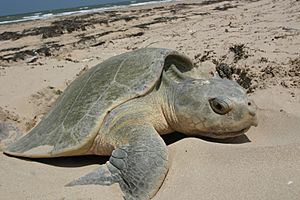
A beach is a tough place for plants and animals to live because conditions change so much. Some animals dig into the sand and eat things that waves bring in. Crabs, insects, and shorebirds then feed on these beach dwellers. The endangered piping plover and some tern species use beaches for nesting. Sea turtles also bury their eggs in ocean beaches. Seagrasses and other beach plants grow in quiet parts of the beach and dunes.
Ocean beaches are home to creatures that can handle salt spray, being covered by tides, and shifting sands. Some of these animals and plants are found only on beaches. In the southeastern U.S., examples include plants like sea oats, sea rocket, beach elder, beach morning glory (Ipomoea pes-caprae), and beach peanut. Animals include mole crabs (Hippoidea), coquina clams (Donax), ghost crabs, and white beach tiger beetles.
Images for kids
-
Beaches like this one on the Gold Coast of Australia can be kept beautiful with beach nourishment projects.
-
Marine debris (trash from the ocean) washed up on a beach in Hawaii.
-
Beach Zones A berm is a high, flat part that stays dry except during very high tides or storms. The swash zone is covered and uncovered by waves. The beach face is the slope where waves wash over. The wrack line (not shown) is where the highest tide leaves debris. Sand dunes can be found behind the berm. -
Sand and shingle are moved and sorted by waves and currents.
-
A sandspit can form if a beach suddenly changes direction.
-
A beach in the Galápagos Islands that is set aside for marine animals.
-
Anse Source d'Argent, La Digue, Seychelles.
-
The seaside view of Monte Carlo in the 1870s.
-
Tourists enjoying the Mediterranean Sea beach in Barcelona, 2007.
-
Pärnu, the summer capital of Estonia, is famous for its sand beaches by the Baltic Sea.
See also
 In Spanish: Playa para niños
In Spanish: Playa para niños



